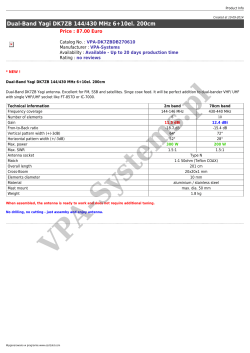
Signal Exploitation and Geolocation
• analysis, analytics, visualization, & reporting • antennas & propagation • array processing • cloud computing • signal processing • communications solutions • cross-domain solutions • electromagnetic modeling • electronic attack • electronic warfare • intelligence networking • GPS engineering • high-performance computing • information exploitation • geolocation • information operations • life-cycle support • signals intelligence • micro-SIGINT • surveillance systems • tagging, tracking, & locating solutions • situational awareness • intelligence, surveillance, & reconnaissance • radio frequency (RF) design • autonomous sensing platforms, devices, & systems • tactical networking • multi-INT processing, exploitation, & dissemination D019795_0086 Signal Exploitation and Geolocation A s the volume and nature of communication signals proliferate and evolve, Southwest Research Institute is focusing efforts on supporting the United States and foreign governments with innovative communications signal intercept, direction-finding, surveillance, geolocation, and tracking technologies. “Multi-intelligence,” the fusion of multiple types of data, provides a big-picture snapshot of information for military and surveillance operations. Applying our expertise in signals intelligence as well as artificial intelligence, we are developing automated systems to collect, process, and analyze enormous volumes of real-time data from multiple sources to report relevant actionable information based on sensor, data, and user-contextual needs. These systems provide tactical, operational, and strategic information in real time and near real time (ad.swri.org). Our staff has been actively involved in all aspects of angleof-arrival geolocation networks. We have delivered the initial operational capability for a high-performance worldwide SwRI 18 geolocation network. That system includes modern messaging technology, innovative mission management, highperformance data storage, retrieval, display, advanced geolocation algorithms, and new network management and monitoring capabilities. In conjunction with this effort, we are establishing angle-of-arrival capability between dissimilar systems to provide geolocation network interoperability. D021251 We recently upgraded the antenna pattern collection capabilities at our 200-acre field test site (antenna shown atop tower) and rotary test site, which measures far-field antenna patterns for up to 16 antenna elements over a 360-degree axis of rotation. The new data collection system provides more accurate measurements at speeds more than five times faster than the previous system. This work is being accomplished through the use of the Theater Netcentric Geolocation (TNG) infrastructure. As a member of TNG working groups, SwRI is a leader in the advancement of angle-of-arrival operations in tactical geolocation network operations. Our researchers also are optimizing the process of searching for and analyzing new communication signals, which must frequently be performed manually. We are investigating “locateto-collect” concepts to determine every signal’s geographic origin first and then highlight only those signals emanating from a geographic region of interest for further scrutiny and analysis. To address emerging maritime communications requirements, we are developing a new VHF/UHF architecture that integrates multiple-channel wideband digital receivers, enhanced network data flow, enhanced VHF/UHF signal characterization, and tactical operator displays. The Naval Air Systems Command awarded SwRI a program to develop VHF/UHF SIGINT direction finding technology. The program includes developing field-programmable gate array (FPGA) processing and airborne geolocation algorithms. We are developing a prototype robot system to inspect overhead power lines and demonstrated its ability to operate in demanding environments, such as heavy rain and freezing cold. Future efforts include using the robot on an operating power trans mission line. We recently applied our expertise in complex radio frequency and image and digital communication signal processing to space flight systems requiring high reliability. SwRI uses internal research funds to help develop new technologies and pave the way for client-sponsored programs. For one project, we integrated a VHF/UHF frequency band operator-driven signal survey capability that covers up to 320 megahertz of bandwidth instantaneously. Signal processing functions SwRI developed a system to speed up the analysis of communication signals data. This color-coded image shows the direction of arrival of multiple signals. Those originating in geographic regions of interest can be isolated for further analysis. are software defined and hosted on commodity multicore servers (signalexploitation.swri.org). We also funded the development of a VHF/UHF direction finding system in a compact pod that can be installed in multiple helicopter platforms. In addition, we developed FPGA-based demodulators and decoders to reduce size, weight, and power applications for unmanned aerial systems. Visit sigint.swri.org for more information or contact Vice President Nils Smith at (210) 522-3685 or nils.smith@swri.org. SwRI recently designed, integrated, and delivered an HF/VHF/UHF compact portable wideband survey and collection system called Scout™. D021243 19 SwRI
© Copyright 2025











